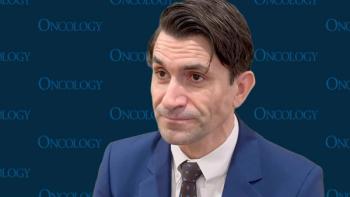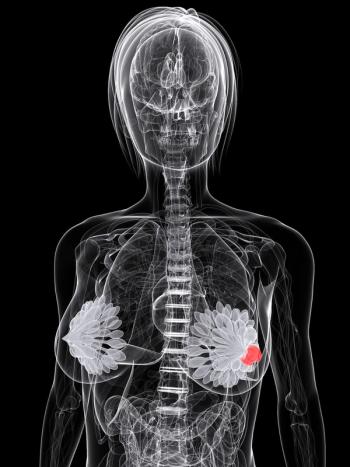
High-Risk Ovarian Cancer Benefits From Niraparib Plus Bevacizumab Combo After Platinum-Based Therapy
Data presented at 2022 SGO from the phase 2 OVARIO trial show promise of niraparib plus bevacizumab in high-risk ovarian cancer treated with frontline platinum-based chemotherapy.
Updated data from the phase 2 OVARIO trial (NCT03326193) demonstrated efficacy of niraparib (Zejula) plus bevacizumab (Avastin) in patients with newly diagnosed advanced ovarian cancer who received 1 line of platinum-based chemotherapy, according to data presented at SGO.
Melissa Hardesty, MD, MPH, added that combination had a safety profile consistent with the known adverse effects of each treatment as monotherapy and results were consistent regardless of biomarker status.
At the June 16, 2021, data cutoff point, patients who received the PARP inhibitor niraparib plus the vascular endothelial growth factor-A inhibitor bevacizumab (N = 105) achieved a median progression-free survival (PFS) of 19.6 months (95% CI, 16.5-25.1). The 18-month PFS rate was 62% (95% CI, 52%-71%) and the 24-month PFS rate was 53% (95% CI, 43%-63%). Median follow-up was 28.7 months (interquartile range, 23.9-32.5).
“OVARIO enrolled a high-risk population,” said Hardesty, a gynecologic oncologist with Alaska Women’s Cancer Care in Anchorage. “More than half of the patients remained progression-free at 24 months. Clinical benefit [by PFS] was observed in the overall population, and across biomarker subgroups in a continuum.”
OVARIO enrolled patients with high-grade serous or endometrioid stage IIIB to IV epithelial ovarian, fallopian tube, or peritoneal cancer. Eligible patients achieved a complete response (CR), partial response (PR), or no evidence of disease (NED) result after treatment with front-line platinum-based chemotherapy plus bevacizumab.
Patients weighing less than 77 kg and/or with a platelet count below 150,000 per µL (n = 82) received niraparib 200 mg daily plus bevacizumab 15 mg/kg once every 3 weeks. All other patients (n = 23) were treated with niraparib 300 mg daily plus bevacizumab 15 mg/kg once every 3 weeks. All patients underwent tissue testing for HRD at enrollment.
The primary end point of the trial was PFS rate at 18 months. Secondary end points included median PFS, overall survival (OS), time to first therapy, and safety. PFS rate at 6 and 12 months were exploratory end points.
The median age of patients included in the trial was 60 (range, 37-82).Most patients had and ECOG performance status of 0 (63%), stage IIIC disease at diagnosis (68%), serous histology (95%). Investigators observed HRD positivity at a rate of 47%, and 63% of patients underwent prior treatment with neoadjuvant chemotherapy or IDS debulking surgery. A majority of patients had a CR or NED to their prior surgery or chemotherapy (58%) and 42% experienced a PR.
Results showed that the median time to first subsequent treatment was 17.5 months (95% CI, 14.5-20.7). Notably, median time to second progression was not evaluable (NE; 95% CI, 32.1-NE). OS data was immature at the time of the analysis, with an event rate of 23.8%.
Investigators noted a higher median PFS patients in HRD subgroup compared with the homologous recombination proficient (HRP) and homologous recombination not determined (HRnd) subgroups, 28.3 months (n = 49; 95% CI, 19.9-NE) versus 14.2 months (n = 38; 95% CI, 8.6-16.8) and 12.1 months (n = 18; 95% CI, 8-NE), respectively. Within the HRD subgroup, patients with BRCA alterations (n = 29) had a median PFS of NE (95% CI, 19.3-NE), while patients with BRCA wild-type mutations (n = 16) had a median PFS of 28.3 months (95% CI, 12.1-NE).
No new safety signals were observed with the combination; all patients experienced a treatment-related adverse event (TRAE) of any grade. Most patients (80%) had a TRAE of at least grade 3, with 77% of these determined to be related to niraparib and 51% attributed to bevacizumab. TRAEs leading to treatment interruption, dose reduction, or treatment discontinuation were reported in 88%, 74%, and 40% of patients, respectively.
The most common TRAEs of any grade included thrombocytopenia (70%), fatigue (57%), anemia, and nausea (both 52%). Commonly occurring TRAEs grade 3 or higher included thrombocytopenia (39%), anemia (34%), and hypertension (27%), among others.
Investigators also noted that treatment with niraparib plus bevacizumab resulted in no clinically meaningful impact on patient quality of life; the baseline score was 25.7 (standard deviation [SD], 3.79) with a mean change from baseline of -0.7 (SD, 0.35).
“There was no impact on quality of life as assessed by change in FOSI [Functional Assessment of Cancer Therapy-Ovarian Symptom Index] score,” Hardesty concluded.
Reference
Hardesty M, Krivak T, Wright GS, et al. OVARIO, a phase 2 study of niraparib + bevacizumab in advanced ovarian cancer following front-line platinum-based chemotherapy with bevacizumab: updated analysis. Presented at: SGO Annual Meeting on Women’s Cancer; March 18 -21, 2022; Phoenix, AZ. Abstract 40.
Newsletter
Stay up to date on recent advances in the multidisciplinary approach to cancer.
















































































